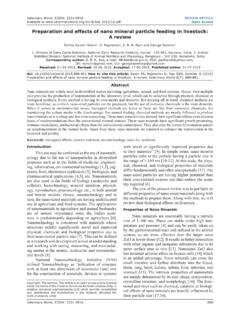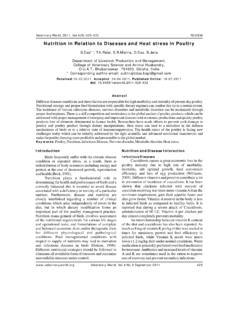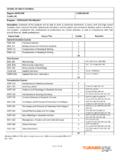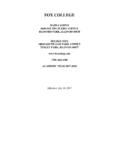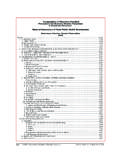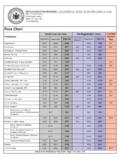Transcription of Myelography in dogs - Veterinary World
1 Veterinary World , , , May 2008 IntroductionMyelography is the special radiographic tech-nique by which the spinal cord is outlined by a posi-tive contrast medium injected into the sub-arach-noid space (Wheeler, 1989). Prompt and accuratediagnosis is the foremost requirement for treatingspinal trauma in dogs. Radiography is one of themost important diagnostic aids for localization ofspinal injuries. Plain radiography, though, revealsfractures and luxations in spine, yet, usually fail tosuggest any compression (Horlein, 1978)and othersoft tissue disorders. Myelography performed follow-ing plain radiography, aids in confirmation and lo-calization of spinal injury and evaluation of its se-verity and extent (Horlein, 1978).
2 IndicationsMyelography is indicated when focal spinalcord lesion is suspected and no inflammatory re-sponse is seen on CSF analysis. The contrast me-dia mixes with CSF that surrounds the spinal cordand demonstrates focal spinal cord compression orexpansion. Myelography is performed in the neurological examination indicatesa particular spinal lesion, but none is visibleon plain determine the significance of multiplelesions identified on plain determine the presence of persistent assist in deciding the indications for sur-geryand type of procedure to be perfor med(Wheeler, 1989).TechniquesA) Cisternal Myelography :Horlein, (1978) recom-mended an angle of 45-60o, while Butterworth andGibbs, (1992) gave a tilt of 15o.
3 Thilagar, et al. (1996)recommended 15o inclination for 5-10 minutes toMyelography in dogsY. M. Paithanpagare, P. H. Tank2, M. Y. Mankad1, Kshama Shirodkar1 and H. J. Derashri3 Department of Veterinary Surgery and Radiology,College of Veterinary Science and Animal Husbandry,Anand Agricultural University,Anand - 380 001, Gujarat, Indiaminimize the flow of contrast media into intracranialsub-arachnoid space. Fatone, et al. (1997) tilted thetable to 10-15o for cervical studies to facilitate cau-dal contrast progression. Jaspreet Singh, et al.(1998) in their study gave a tilt of 60o anterior-pos-teriorly and found dye satisfactorily traveled to lum-bosacral region within 5 min.
4 Kumar, et al. (2003)used 15o inclination throughout experimental periodexcept radiographic procedure. Kaur and Singh,(2004) used 45-50o tilt with head held high at high-est position for 3-5 easy access to sub-arachnoid spaceallowing collection of requisite amount of CSFwith minimum chances of blood contamination.(Jaspreet Singh, et al., 1998). insertion is technically contrast medium is required for evalua-tionof cervical to Penderis, et al. (1999), sub duralinjection is most common complicationobserved during cisternal injection of risk of needle puncture into medullaoblongata or cervical spinal cord (Kishimoto,et al.)
5 , 2003).B) Lumbar Myelography :General anaesthesiais administered to the patient. The back is archeddorsally with patient in sternal recumbancy. A 3-inch22 G needle with syringe is introduced in the mid-line just anterior to L6 ( 15th lumbar space). Cere-brospinal fluid 1-3 ml is removed for examinationand medium is injected slowly and carefully. Thespine should be tilted for some time toward the head(20o) to encourage cranial migration. Radiographsare made on similar intervals as cisterna is safer than cisternal punctureREVIEWV eterinary World , (5):152-154152 Veterinary World , , , May is useful for compressive lesions of thoraco-lumbar useful in cases with acute disc it is more difficult than cisternalmyelography (McCartney, 1997).
6 , et al. (2003) reported various sideeffects of lumbar Myelography as spinal cordedema, cystic necrosis, myelomalacia, axonalnecrosis and ) Lumbosacral cord terminates at caudal lumbar sothere is minimal risk for cord Myelography is less difficultbecause of large site is easily neurological signs, including seizures areobserved after MediaThe selection of contrast medium has a crucialrole in myelographic examination. The ideal contrastpreparation, should be minimal neurotoxic, shouldbe pharmacologically inert, miscible with CSF andradio opaque at an isotonic concentration (Widmerand Blevins, 1991). A number of contrast media havebeen recommended for Myelography , which includeionic and non-ionic monomers of benzoic contrast media are:1.
7 Oil based contrast media: Pentoplaque,thorotrast, neo-ipex (75%), idochlorol, skiodon(20%), lipidal and diodrast (35%) are various typemedia. Vaughan, 1990 listed various disadvantagesof oil-based contrast medium such as poordiagnostic quality, poor flow characteristics, tendencyto globulate, and post myelographic of the above disadvantages oil basedcontrast media are no longer Non-ionic water-soluble contrast agents: Theyare Metrizamide, Iohexol and : Complications from radiographiccontrast media depend on variety of factors, includingthe route of administration, chemical compositionof the media and the patients underlying condition,the mechanical effect of needle placement is also , et al.
8 (1997)performed iohexolmyelography with concentration of 300 mg I2 was observed as a side effect in this mentioned other side effects like fasciculation,seizures, bradycardia, vomiting, fatal cardiopul-monary arrest, death due to acute sub duralhemorrhage involving brain stem and cranial cervicalspinal cord caused by wrong needle , (1997) observed no side effects in 79days who had undergone Myelography , however, hementioned a possibility of iotrogenic hydromelia dueto rapid injection under pressure leading toneurological Poor radiographic quality: Incorrect patientpositioning, incorrect exposure or artifact results intopoor radiographic quality.
9 Myelography should beperformed only after satisfactory quality surveyradiographs have been obtained and Poor distribution of contrast medium-Inadequate volume injected-Incorrect injection site-Epidural opacification-Contrast not inadequately mixed with CSF-Incorrect radiographic views3. Pathoanatomical problems-Normal anatomical variations-Spinal cord swellingClearance of DyeGetty (1977) observed quick elimination ofcontrast agent from sub-arachnoid space and statedthe reason to be fast absorption of contrast mediumby dense venous plexus. Widmer (1989) observedthat after Myelography contrast medium carries ingeneral circulation following its absorption by venousplexus of spinal column and finally it is excreted bykidney.
10 Carroll, et al. (1997) reported that passivesubarachnoid elimination of contrast medium occurswith the outflow of CSF into venous blood. Thollot,et al. (2006) indicated that radiographic contrastmedia are eliminated exclusively by is radiography followingopacification of the sub-arachnoid and Iopamidol are commonly usedcontrast filling of spinal column is observed tobe dose of these dyes at 300-350 mgI2/ml is commonly chosen. Recommendedvolumes of contrast media for Myelography indogs are generally accepted to be media distribution in the sub- Myelography in dogs153 Veterinary World , , , May 2008arachnoid space may be improved by creatingturbulence during injection of contrast medium,warming of contrast medium to minimize itsviscosity.



